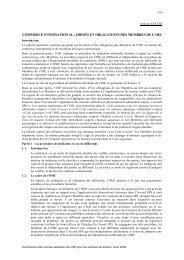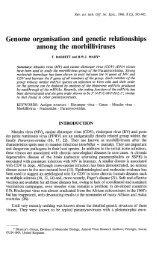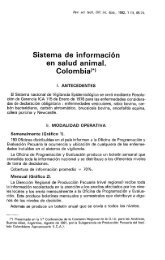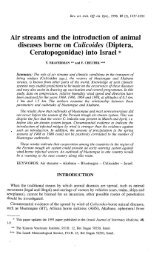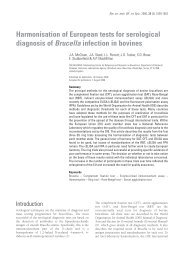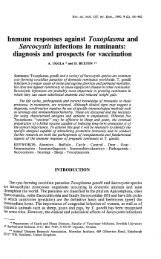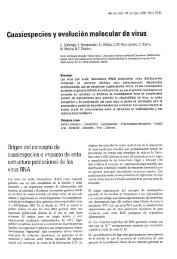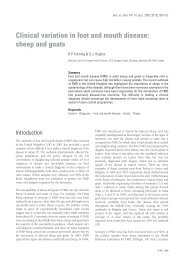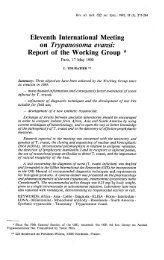26th Conference of the OIE Regional Commission for Asia
26th Conference of the OIE Regional Commission for Asia
26th Conference of the OIE Regional Commission for Asia
Create successful ePaper yourself
Turn your PDF publications into a flip-book with our unique Google optimized e-Paper software.
176. Dr Kida noted that on <strong>the</strong> basis <strong>of</strong> our knowledge <strong>of</strong> <strong>the</strong> ecology and evolution <strong>of</strong> influenza<br />
viruses such as <strong>the</strong> natural reservoir, perpetuation in nature, host range, interspecies<br />
transmission, antigenic and genetic variation <strong>of</strong> influenza viruses, and mechanisms <strong>of</strong> <strong>the</strong><br />
emergence <strong>of</strong> pandemic strains in humans and HPAIV strains in domestic poultry, along with<br />
<strong>the</strong> answers to <strong>the</strong> questionnaire sent to <strong>OIE</strong> Members, <strong>the</strong> following discussion <strong>for</strong> <strong>the</strong><br />
recommendation should be made;<br />
1. Why have <strong>the</strong> H5N1 highly pathogenic avian influenza virus strain persisted<br />
in <strong>the</strong> world <strong>for</strong> 12 years and been antigenic variant viruses selected?<br />
2. Do <strong>the</strong> H5N1 HPAIV strains perpetuate in <strong>the</strong> lakes where migratory birds<br />
nest?<br />
3. What is <strong>the</strong> best measure <strong>for</strong> <strong>the</strong> control <strong>of</strong> avian influenza?<br />
4. Vaccination <strong>of</strong> poultry should not be applied “instead <strong>of</strong>” but “in addition to”<br />
<strong>the</strong> basic and standard control measures <strong>of</strong> HPAI such as stamping out,<br />
movement controls <strong>of</strong> poultry and bio-security.<br />
5. Preparedness <strong>for</strong> pandemic influenza should be based on <strong>the</strong> measures how to<br />
control <strong>the</strong> seasonal influenza.<br />
6. Streng<strong>the</strong>ning Veterinary Services to comply with <strong>OIE</strong> international<br />
standards on quality must be <strong>the</strong> way to prevent occurrence and spread <strong>of</strong><br />
Animal Influenza viruses, as well as o<strong>the</strong>r relevant pathogens.<br />
177. Finally, Dr Kida presented <strong>the</strong> summary <strong>of</strong> answers from <strong>OIE</strong> Members to <strong>the</strong> Questionnaire<br />
on Technical Item 1: “Influenza development, including H1N1, surveillance and postvaccination<br />
monitoring <strong>of</strong> H5N1”, as follows:<br />
178. 23 Members, out <strong>of</strong> 34 Members <strong>of</strong> <strong>the</strong> <strong>OIE</strong> <strong>Regional</strong> <strong>Commission</strong> <strong>for</strong> <strong>Asia</strong>, <strong>the</strong> Far East and<br />
Oceania answered to <strong>the</strong> questionnaire. on Technical Item I: “Influenza development,<br />
including H1N1, surveillance and post-vaccination monitoring <strong>of</strong> H5N1”<br />
179. Only Indonesia in<strong>for</strong>med on detection <strong>of</strong> HPAI virus infection in pigs, or pandemic H1N1 2009<br />
virus infection in pigs or birds detected virologically or serologically in <strong>the</strong> country during <strong>the</strong><br />
past 5 years. 11 Members in<strong>for</strong>med on initial location highly pathogenic avian influenza and/or<br />
low pathogenic avian influenza virus outbreaks in <strong>the</strong> country in each year since 2003.<br />
180. Typical signs were in<strong>for</strong>med regarding <strong>the</strong> initial suspicion <strong>of</strong> <strong>the</strong> disease: High morbidity and<br />
mortality, remarkable egg drop, production losses, respiratory clinical signs and o<strong>the</strong>r<br />
symptoms. The diagnostic was made by: Clinical signs, virological findings and serological<br />
findings (HI, Real-time RT-PCR, virus isolation), and pathological findings.<br />
181. Laboratory tests were carried out at Local and National laboratories, and some at<br />
International reference laboratories.<br />
182. In 6 Members (Bangladesh, Cambodia, China, Indonesia, Pakistan, Vietnam) <strong>the</strong> HPAI H5N1<br />
impacted on public health,<br />
183. In five Members (Australia, Cambodia, Indonesia, Pakistan, Vietnam) a link between animal<br />
and human infection was established.<br />
184. Control measures which were taken included: stamping-out, or partial stamping-out with<br />
compensation, movement control, closure <strong>of</strong> live bird markets (during <strong>the</strong> outbreak period),<br />
vaccination and communication.<br />
185. China, Indonesia, Pakistan, Vietnam also applied subsequent vaccination as a complementary<br />
control measure.<br />
186. 8 Member have developed respective economic studies to estimate <strong>the</strong> losses caused by <strong>the</strong><br />
disease, ranging from 1,4 to 4,3 millions US$.<br />
27





